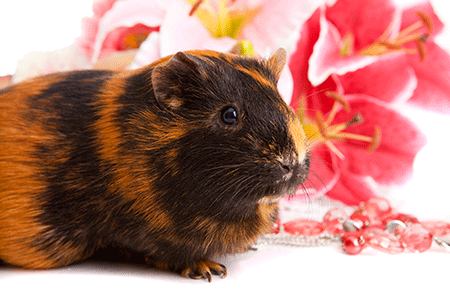Guinea Pig Care Checklist

Choosing the right pet takes knowledge and preparation. In this checklist, we have gathered information from multiple sources to bring you the most thorough and concise guide to guinea pig care. Guinea pigs are long-term investments–they can live up to 8 years and require lots of attention. They are social creatures that are happiest living in same-sex pairs. If your new piggy is acting shy and frightened, not to worry! By following this checklist, your guinea pig will soon be squealing with joy any time you enter the room.
- A Large Cage—According to the United States Humane Society, the recommended cage size is a minimum of 7.5 square feet. For two piggies, a minimum of 10.5 square feet, and for three, at least 13 square feet. A larger cage actually makes for less work. With more space, waste builds up at a slower rate, requiring less frequent cleaning.
- Proper Bedding–Although many stores market pine and cedar wood chips as ideal sources of bedding, they contain chemicals which can negatively affect your pet’s health. Safer, preferable options include aspen wood chips, shredded paper, and Carefresh wood pulp. Fleece cloth can also be used to line the cage, but requires more frequent changing than other options. To protect your pet’s sensitive feet, bedding should be at least 2-3 inches thick.
- Constant Water Source–A full drip water bottle is a necessity, and its contents should be changed daily. Avoid tap water, distilled water, or mineral supplements, and opt for unflavored, bottled water. Be sure to clean the tip of the water bottle weekly, as built-up food residue can breed bacteria and block water flow.
- Proper Food Sources–Unlike many larger animals, guinea pigs not eat meals at scheduled times. They are healthiest when given the option to graze throughout the day and night, making hay a must-have. Timothy hay provides nutrients, supports healthy digestion, and helps keep teeth filed down. For additional nutrients, about ¼-⅛ cup of pellets should be fed daily. It is important to use pellets manufactured specifically for guinea pigs, as pellets for other small animals will lack adequate nutrients. The best pellets options are dye-free and loaded with Vitamin C.
- Hiding Structure–A wooden hiding structure is a multi-purpose necessity in your piggy’s cage, serving as both a safe haven and a tool for filing their teeth. If you have more than one piggy, make sure there is more than one structure available.
- Time Outside of the Cage–Guinea pigs are active animals, and require plenty of exercise in order to stay fit and healthy. Although they will get some exercise in their habitats, they require daily time outside of their cages.Before letting them roam freely, make sure the area is free of wires, plants, and small crawl spaces. Avoid busy, loud rooms to ensure they are relaxed and can fully benefit from the experience.
- Gentle Handling & Attention–Most piggys enjoy being handled by their owners, but it does take time to build adequate trust. Hand-feeding treats and talking softly are great ways to begin a caring relationship. Gentle strokes between the ears and under the chin are usually welcomed, and with the proper techniques, more active handling is also acceptable. Follow this guide to safe handling.
- Proper Veterinary Care–Before taking one home, ensure there is veterinarian who specializes in small animals in your area. As prey animals, they are masters at hiding illness. Signs of sickness include refusal to eat or drink, weight loss, labored breathing, swollen abdomen, and unusual lethargy. If you think that your animal is unwell, don’t wait for it to get better, contact your veterinarian immediately.

